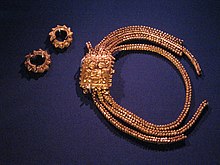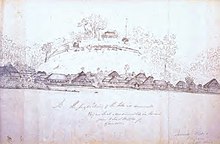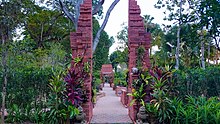Fort Canning Hill
The hill has a long history intertwined with that of the country due to its location as the highest elevation within walking distance to the city's civic district, within the Downtown Core.It is believed that the Fort Canning Hill area was once the centre of ancient Singapura that thrived in the 14th century, and was occupied by a palace with various buildings of political, religious and commercial significance.[5][6][7] A series of archaeological digs that began in 1984 have uncovered evidence of workshops for glass and gold that dated to the 14th century, and a ceremonial or religious area near the summit.[8] Historical sources also indicate that around the end of the 14th century, Singapura was attacked by either the Majapahit or the Siamese, forcing its ruler Parameswara to move on to Melaka where he founded the Sultanate of Malacca.In the early period of 19th century Singapore, the stream was used to provide clean drinking water for all ships stopping at the port until the demand exceeded the capacity, and the spring dried up as wells were dug around the hill.Farquhar drew up the first gun and set up the post to hoist the Union Jack on top of the hill, marking the birth of Singapore as a British settlement.Upon his return in October 1822 and impressed with Coleman's design, Raffles approved the house, construction of which was soon begun on Singapore Hill in November 1822 and completed by January 1823.[16] On 2 August 1824, Temenggong Abdul Rahman, Sultan Hussein, and John Crawfurd signed the Treaty of Friendship and Alliance at the hill.[19] However, the fortifications were considered a failure from the beginning, as ships could easily get close enough to destroy the town yet remain out of range of the fort's guns.The Van Kleef Aquarium was first constructed in 1955 at the foot of Fort Canning Hill known as King George V Jubilee Park facing River Valley Road.The unique blend of historical relics, lush greenery and expansive lawns has made Fort Canning a hub of cultural and artistic activity.It has been a venue of choice for staging myriad outdoor events and activities like theatre carnivals such as Shakespeare in the Park by SRT, art festivals, starlight cinemas and Ballet Under the Stars performances.Other enhancements to the park include a new heritage museum at the Fort Canning Centre, a reproduction of an ancient spring and improvements in accessibility.














ElevationCoordinatesMuseum Planning AreaParent rangeMountain typeSingaporeCentral Areacentral business districtlong historyDowntown CoreViscount Charles John Canningancient SingaporeBan ZuWang DayuanResidentsGovernorsFort Canning ReservoirFort Canning ParkEarly history of SingaporeTopynymyTemasekLong Ya MenMalay AnnalsKingdom of SingapuraSang Nila UtamaParameswaraBadangArchaeology in SingaporeSingapore StoneSingapore Riverancient SingapuraDaoyi ZhilüeMajapahitSiameseMelakaSultanate of MalaccaJohn CrawfurdSong dynastyIskandar ShahTemenggong Abdul RahmanHussein ShahThe Singapore TreatyStamford RafflesWilliam FarquharUnion JackResident and Commandant of SingaporeRaffles HouseBencoolenSumatraGeorge Drumgold ColemanResidency HouseGovernors of SingaporeGovernment HousePavilionTreaty of Friendship and AllianceSamuel George BonhamViceroy of IndiaHeadquarters Malaya Command Operations BunkerBritish ArmyWorld War IILieutenant-GeneralArthur Ernest PercivaloccupationThe Battle BoxSingapore Armed ForcesSingapore Command and Staff CollegeVan Kleef AquariumNational Theatre, SingaporeNational DayCentral ExpresswayNational Parks BoardFort CanningClarke QuayDhoby GhautLee Kuan YewOrchard Roadrecreationaldowntown city arearelicsartisticcarnivalsFort Canning Tunnelsally portSecond World WarCommander of British Forcesbunkersfortresscannonsdefensivesalutebatteryreplicabotanical gardenSir Stamford RafflesnutmeggothiccupolasGeorge Drumgoole Colemanland reclamationconstruction of roadsArmenian ChurchWilliam NapierbarracksWilliam MarsdenJohn MiksicartefactsporcelainearthenwareMalay kingdomPalembang princeFort Canning LighthouseList of parks in SingaporeThe Straits TimesNewspaperSGPaul WheatleyUniversity of Malaya PressThe Business TimesC.M. TurnbullThe Singapore Free PressTODAYonlineMediaCorpParks in SingaporeBidadari ParkDhoby Ghaut GreenEsplanade ParkGardens by the Bay